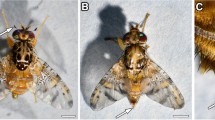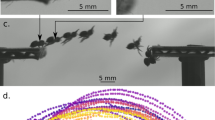Abstract
Among animals, insects have the highest mass-specific metabolic rates; yet, during intermolt development the tracheal respiratory system cannot meet the increased oxygen demand of older stage insects. Using locomotory performance indices, whole body respirometry, and X-ray imaging to visualize the respiratory system, we tested the hypothesis that due to the rigid exoskeleton, an increase in body mass during the intermolt period compresses the air-filled tracheal system, thereby, reducing oxygen delivery capacity in late stage insects. Specifically, we measured air sac ventilation frequency, size, and compressibility in both the abdomen and femur of early, middle, and late stage sixth instar Schistocerca americana grasshoppers. Our results show that late stage grasshoppers have a reduced air sac ventilation frequency in the femur and decreased convective capacities in the abdomen and femur. We also used X-ray images of the abdomen and femur to calculate the total proportion of tissue dedicated to respiratory structure during the intermolt period. We found that late stage grasshoppers had a lower proportion of their body dedicated to respiratory structures, especially air sacs, which convectively ventilate the tracheal system. These intermolt changes make oxygen delivery more challenging to the tissues, especially critical ones such as the jumping muscle. Indeed, late stage grasshoppers showed reduced jump frequencies compared to early stage grasshoppers, as well as decreased mass-specific CO2 emission rates at 3 kPa PO2. Our findings provide a mechanism to explain how body mass changes during the intermolt period reduce oxygen delivery capacity and alter an insect’s life history.








Similar content being viewed by others
References
Badman J, Harrison JF, McGarry MP (2007) Grasshoppers in research and education: methods for maintenance and production. Lab Anim 36(3):27–31
Chapman RF (1998) The insects: structure and function. Cambridge University Press, Cambridge
Clarke KU (1957) On the role of the tracheal system in the post-embryonic growth of Locusta migratoria L. Proc R Entomol Soc London A 32:67–79
Davis AR, Solomon KR, Shuel RW (1988) Laboratory studies of honeybee larval growth and development as affected by systemic insecticides at adult-sublethal levels. J Apic Res 27:146–161
Degens H, Horneros JMS, Hopman MTE (2006) Acute hypoxia limits endurance but does not affect muscle contractile properties. Muscle Nerve 33(4):532–537
Gabriel JM (1985a) The development of the locust jumping mechanism. I. Allometric growth and its effects on jumping performance. J Exp Biol 118:313–326
Gabriel JM (1985b) The development of the locust jumping mechanism. II. Energy storage and muscle mechanics. J Exp Biol 118:327–340
Greenberg S, Ar A (1996) Effects of chronic hypoxia, normoxia, and hyperoxia on larval development in the beetle Tenebrio molitor. J Insect Physiol 42(11–12):991–996
Greenlee KJ, Harrison JF (1998) Acid-base and respiratory responses to hypoxia in the grasshopper Schistocerca americana. J Exp Biol 201(20):2843–2855
Greenlee KJ, Harrison JF (2004) Development of respiratory function in the American locust Schistocerca americana II. Within-instar effects. J Exp Biol 207(3):509–517
Greenlee KJ, Harrison JF (2005) Respiratory changes throughout ontogeny in the tobacco hornworm caterpillar, Manduca sexta. J Exp Biol 208(7):1385–1392
Greenlee KJ, Henry JR, Kirkton SD, Westneat MW, Fezzaa K, Lee WK, Harrison JF (2009) Synchrotron imaging of the grasshopper tracheal system: morphological and physiological components of tracheal hypermetry. Am J Physiol Regul Integr Comp Physiol 297(5):R1343–R1350
Harrison JF (1997) Ventilatory mechanism and control in grasshoppers. Am Zool 37:73–81
Harrison JF (2009a) Respiratory system. In: Resh VH, Carde R (eds) Encyclopedia of insects, 2nd edn. Academic Press, San Diego, pp 889–895
Harrison JF (2009b) Tracheal system. In: Resh VH, Carde R (eds) Encyclopedia of insects, 2nd edn. Academic Press, San Diego, pp 1011–1015
Harrison JF, Roberts SP (2000) Flight respiration and energetics. Annu Rev Biol 62:179–205
Harrison JF, Frazier MR, Henry JR, Kaiser A, Klok CJ, Rascon B (2006) Responses of terrestrial insects to hypoxia or hyperoxia. Respir Physiol Neurobiol 154(1–2):4–17
Hartung DK, Kirkton SD, Harrison JF (2004) Ontogeny of tracheal system structure: a light and electron-microscopy study of the metathoracic femur of the American locust, Schistocerca americana. J Morphol 262(3):800–812
Hendricks GM, Hadley NF (1983) Structure of the cuticle of the common house cricket with reference to the location of lipids. Tissue Cell 15:761–779
Juel C (1996) Lactate proton co-transport in skeletal muscle: regulation and importance for pH homeostasis. Acta Physiol Scand 156(3):369–374
Kaiser A, Klok CJ, Socha JJ, Lee WK, Quinlan MC, Harrison JF (2007) Increase in tracheal investment with beetle size supports hypothesis of oxygen limitation on insect gigantism. Proc Natl Acad Sci USA 104(32):13198–13203
Katz SL, Gosline JM (1993) Ontogenetic scaling of jump performance in the African desert locust (Schistocerca gregaria). J Exp Biol 177:81–111
Katz SL, Gosline JM (1994) Scaling modulus as a degree of freedom in the design of the locust legs. J Exp Biol 187:207–223
Kirkton SD (2007) Effects of insect body size on tracheal structure and function. In: Roach RC, Wagner PD, Hackett PH (eds) Hypoxia and the circulation. Advances in experimental medicine and biology, vol 618. Springer, Berlin, pp 221–228
Kirkton SD, Harrison JF (2006) Ontogeny of locomotory behaviour in the American locust, Schistocerca americana: from marathoner to broad jumper. Anim Behav 71:925–931
Kirkton SD, Niska JA, Harrison JF (2005) Ontogenetic effects on aerobic and anaerobic metabolism during jumping in the American locust, Schistocerca americana. J Exp Biol 208(15):3003–3012
Krolikowski K, Harrison JF (1996) Haemolymph acid–base status, tracheal gas levels and the control of post-exercise ventilation rate in grasshoppers. J Exp Biol 199:391–399
Kuitert LC, Connin RV (1952) Biology of the American grasshopper in the southeastern United States. Fla Entomol 35:22–33
Lease HM, Wolf BO, Harrison JF (2006) Intraspecific variation in tracheal volume in the American locust, Schistocerca americana, measured by a new inert gas method. J Exp Biol 209(17):3476–3483
Marden JH (1988) Bodybuilding dragonflies: costs and benefits of maximizing flight muscle. Physiol Zool 62(2):505–521
Matsuki M, Ayres MP, MacLean SF Jr (1994) Temperature effects on growth and molt of Nematus calais (Hymenoptera: Tenthredinidae). Environ Entomol 23:719–725
Nijhout HF (1975) A threshold size for metamorphosis in the tobacco hornworm, Manducta sexta (L.). Biol Bull 149:214–225
Nijhout HF (1979) Stretch-induced molting in Oncopeltus fasciatus. J Insect Physiol 25:277–281
Perry S, Rupp T (2009) Altitude-induced changes in muscle contractile properties. High Alt Med Biol 10(2):175–182
Queathem E (1991) The ontogeny of grasshopper jumping performance. J Insect Physiol 37(2):129–138
Queathem EJ, Full RJ (1995) Variation in jump force production within an instar of the grasshopper Schistocerca americana. J Zool 235:605–620
Roller L, Zitnanova I, Dai L, Simo L, Park Y, Satake H, Tanaka Y, Adams ME, Zitnan D (2010) Ecdysis triggering hormone signaling in arthropods. Peptides 31(3):429–441
Socha JJ, Westneat MW, Harrison JF, Waters JS, Lee WK (2007) Real-time phase-contrast X-ray imaging: a new technique for the study of animal form and function. BMC Biol 5:6
Socha JJ, Forster TD, Greenlee KJ (2010) Issues of convection in insect respiration: insights from synchrotron X-ray imaging and beyond. Respir Physiol Neurobiol 173:S65–S73
Stockhoff BA (1992) Diet-switching by gypsy moth—effects of diet nitrogen history vs switching on growth, consumption, and food utilization. Entomol Exp Appl 64:225–238
Stower WJ, Greathead DJ (1969) Numerical changes in a population of the desert locust, with special reference to factors responsible for mortality. J Appl Ecol 6:203–235
Suarez RK (1996) Upper limits to mass-specific metabolic rates. Annu Rev Physiol 58:583–605
Tammaru T, Esperk T (2007) Growth allometry of immature insects: larvae do not grow exponentially. Funct Ecol 21(6):1099–1105
Wasserthal LT (1996) Interaction of circulation and tracheal ventilation in holometabolous insects. Adv Insect Physiol 26:297–351
Weibel ER (1979) Stereological methods, vol I. Academic Press, London
Westerblad H, Allen DG, Lannergren J (2002) Muscle fatigue: lactic acid or inorganic phosphate the major cause? News Physiol Sci 17:17–21
Wigglesworth VB (1954) Growth and regeneration in the tracheal system of an insect, Rhodnius prolixus. Q J Microsc Sci 95(1):115–137
Wigglesworth VB (1959) The role of the epidermal cells in the ‘migration’ tracheoles in Rhodnius prolixus (Hemiptera). J Exp Biol 36:632–640
Wigglesworth VB (1983) The physiology of insect tracheoles. In: Berridge MJ, Treherne JE, Wiglesworth VB (eds) Advances in insect physiology, vol 17. Academic Press, London, pp 85–148
Acknowledgments
Support for this project was provided by the Union College Faculty Research Fund (SDK), National Science Foundation IOS-0953297 (KJG), and National Institutes of Health 2P20RR0l5566 from the National Center for Research Resources (KJG). The contents of this study are solely the responsibility of the authors and do not necessarily reflect the views of the NIH. Use of the Advanced Photon Source at Argonne National Laboratory was supported by the US Department of Energy, Office of Science, Office of Basic Energy Sciences, under Contract DE-AC02-06CH11357. We would also like to thank Leah Pepe and Kathryn Jackson for assistance with data collection. We would like thank the three anonymous reviewers for their helpful comments in improving the manuscript.
Author information
Authors and Affiliations
Corresponding author
Additional information
Communicated by H.V. Carey.
Rights and permissions
About this article
Cite this article
Kirkton, S.D., Hennessey, L.E., Duffy, B. et al. Intermolt development reduces oxygen delivery capacity and jumping performance in the American locust (Schistocerca americana). J Comp Physiol B 182, 217–230 (2012). https://doi.org/10.1007/s00360-011-0615-x
Received:
Revised:
Accepted:
Published:
Issue Date:
DOI: https://doi.org/10.1007/s00360-011-0615-x




